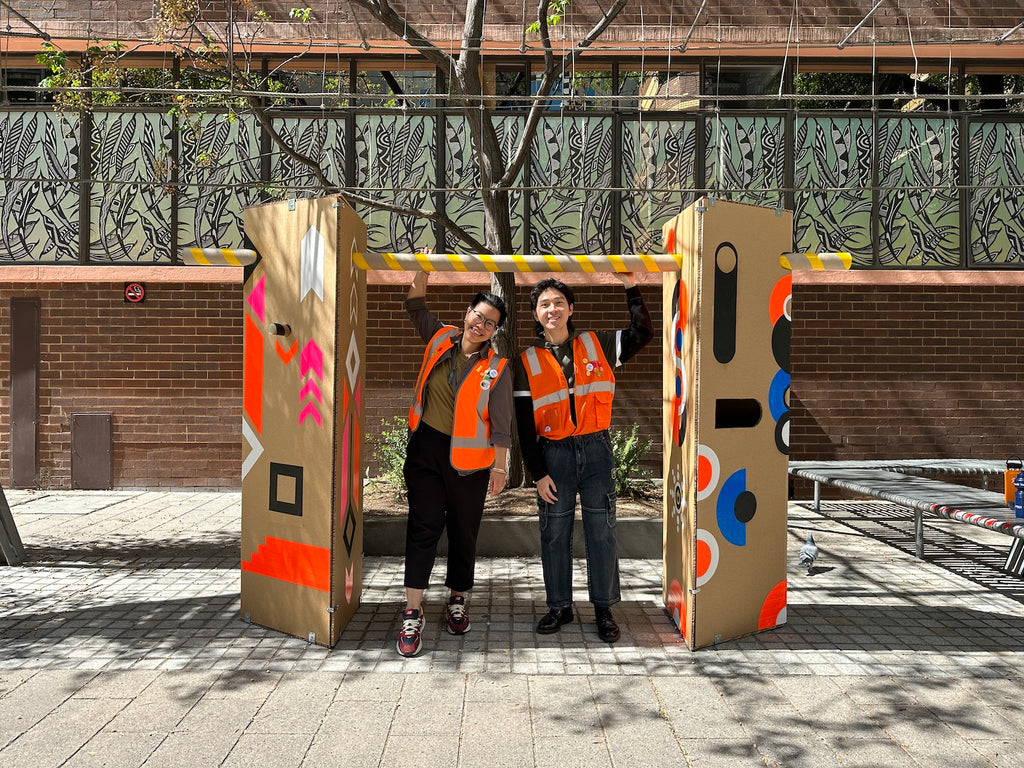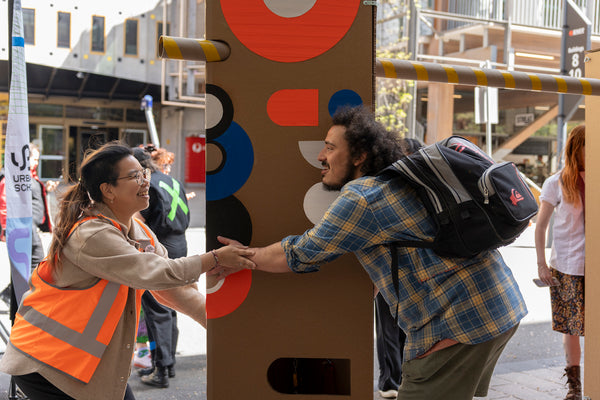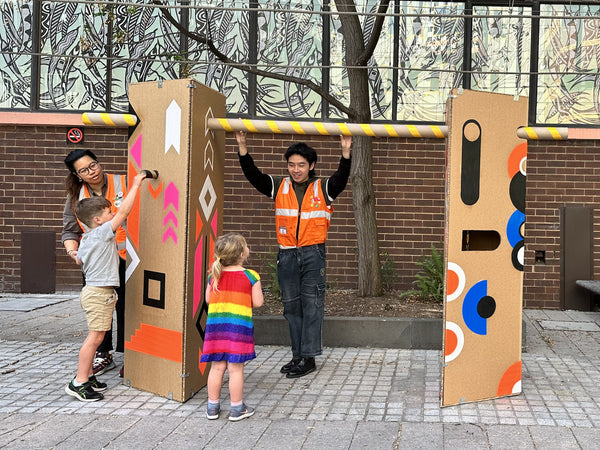Invention Inspiration: Symphony With: Sound Installation by Gin Lin and Nicholas Leong

Symphony With Installation and creators Gin and Nicholas
The Invention: Symphony With
The interactive sound installation, Symphony With, made its debut at the Melbourne International Games Week 2023 and RMIT University Orientation week 2024, captivating participants with its unique blend of art and technology.
Symphony With was developed as part of an art program for RMIT Creative. RMIT Creative connected with Future Play Lab to offer student collaborators the opportunity to develop and test new public art games for fellow students as part of Melbourne International Games Week (MIGW). After testing, participating students are invited to propose their game to be assessed for commissioning.
Check out RMIT Creative's Insta!
Nicholas and Gin created this immersive experience to unfold in two distinct phases: ‘Curiosity’ and ‘Connectivity.’ Each phase invites individuals to engage deeply with their surroundings and with each other.
Symphony With is more than just an installation; it's an opportunity for collaborative expression. As participants delve into the intricate patterns of the cardboard sculpture, they unlock a symphony of sounds. Each pattern produces a different tone, encouraging exploration and discovery.

Symphony With Creator Gin and a Collaborator
To embark on this musical journey, players must adhere to a simple yet engaging set of instructions. With one hand holding the "power button" (wired as Makey Makey EARTH) the other player(s) explores the patterns and participants unlock the hidden melodies within the installation. However, the true magic of Symphony With lies in its emphasis on connection. To access all corners of the sculpture and fully orchestrate their symphony, players must join forces and connect to create harmony.

Symphony With Installation and participants
In essence, Symphony With transcends the boundaries of traditional art installations by fostering collaboration and creativity. It is an ode to the power of collective expression, where participants become explorers and work together to create music.

Symphony With: Playing Music
How Gin and Nicholas Built Symphony With
Gin and Nicholas were challenged to create this as part of the RMIT Creative program that partnered with Future Play Lab a group on campus that believes:
“Urban play connects people and place with design and cities, making them vibrant and liveable, reflecting their creative, linguistic, cultural, social, and urban diversity. The Future Play Lab works across speculative design, creative placemaking, and urban play to explore new ways of being in the world.”
Taking these principles, the team aimed to foster community engagement through urban play, steering away from the digital realm to bring people together in physical spaces. Delving into questions like, "How can we unleash our collective creativity?" and "What forms of play unite rather than isolate?"
The decision to focus on sound as the medium for Symphony With stemmed from the diverse demographics of the university community. Sound, unlike text or visuals, possesses a universal quality, capable of resonating with individuals regardless of their background or language proficiency.

Symphony With: Kids participate
In the beginning, the inventors wanted to have a much larger scale installation that incorporated parts of the campus environment into it. But to keep things safe and work within the time limits, they went for a more straightforward design that still encourages students to explore the campus in a different way. The idea of collaboration was key in having the function of the interaction to change the more players that got involved. The scale of the installation also encouraged people to work together. There were many different sound patterns that could only be reached if students played together.
Make it Yourself
Here are the supplies you need to make your own sound installation like Symphony With.
Makey Makey Products
Digital Assets
Physical Supplies
Here are some of the other supplies that Gin and Nicholas used to create this invention:
- Cardboard (Large refrigerator or appliance boxes)
- Cardboard Tube
- Duct Tape
- Corner Brace to hold cardboard together
- Templates for shapes
- Conductive Paint
- Wire
Steps for Making
Here are the steps, if you want to create your own version of Symphony With:
1. Come up with a sculpture design
- Think about how you want people to interact- how do you want them to work together?
- What should the individual shapes look like that participants touch to play sounds?
- Start small and make a small box prototype before making the larger installation.
2. Make conductive paint
- You can buy conductive paint for your conductive shapes, or you can make your own by mixing graphite and acrylic paint (you will want to test the ratio.)
3. Create patterns for conductive touchpoints
- Print out patterns to use like a stencil.
- Paint templates with conductive paint.
- Use Ducttape to make insulated and colorful embellishments.
- Label all the conductive touchpoints with the keypress they will trigger.
- Screw the box together with corner braces for stability.
4. Attach the Makey Makey to the conductive touchpoints.
- Gin and Nicholas used screws that went through the conductive touchpoint and to the inside of the cardboard pillar. They were able to connect alligator clips and longer gauge wire to the screws to attach the conductive points to Makey Makey.
5. Set up the music:
- Code musical samples in Scratch (Here is an example using WASDFG inputs.
- Use our Makey Makey Sampler to record and play sounds.
- Use a speaker to amplify the sound.
Make it Your Own
Watch our interview above for great tips on building this invention, then use the following questions to brainstorm new remixes for your own version of Symphony With:
- Can you come up with different gestures or different interactions to complete a switch?
- Can you integrate the location?
- with the sound
- or a theme?
- Explore different materials for building your installation. So many things in the world are conductive! How can your material choice make your installation more interesting?
- Could you facilitate it differently? Could someone act as a conductor? And conduct people to create different patterns of sounds?
- Change the sound!
- Each tower could be the same chord to create harmonious sounds.
- Choose different instruments and sounds to make your own style of music.
- Think about Accessibility: Gin and Nicolas had someone with hearing impairments who shared a new unique experience. Since they had a big speaker with heavy bass, he could feel the vibrations. How can you add elements of accessibility to your invention?
Share it With Others
If you recreate or remix this invention inspiration, one of the most important steps is to share it with others! :
- Gin and Nicholas set this up during orientation week and assisted people in play. They showed them how to touch the surface and make sounds that dragged people in.
- They asked questions to encourage people to join like: Do you have time? Can you join our round?
About the Creators
- Gin Lin is a multimedia designer based in Melbourne. Gin has extensive experience in commercial graphic design. In 2023, Gin achieved a significant milestone by completing her Master of Animation, Games, and Interactivity at RMIT Melbourne. With a distinct focus on blending tangible elements with digital content, Gin's work revolves around the art of creating captivating interactivity.
- Nicholas Leong is an industrial designer and maker specializing in designing toys and interactive play installations/experiences for urban public spaces. He is passionate about infusing playfulness and gamification into public spaces to enhance social interactions, encouraging the transformation of people's behaviors and experiences.












